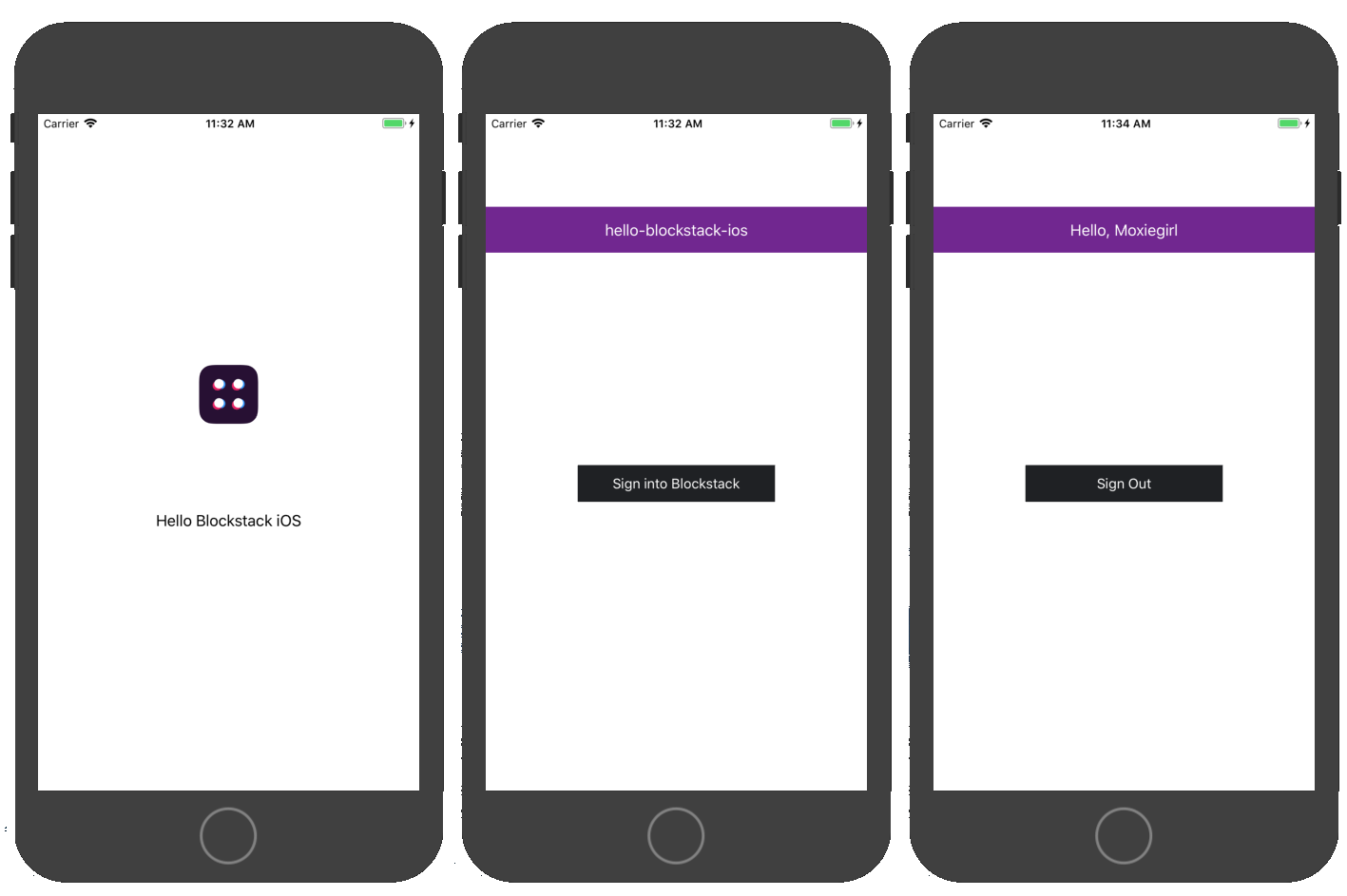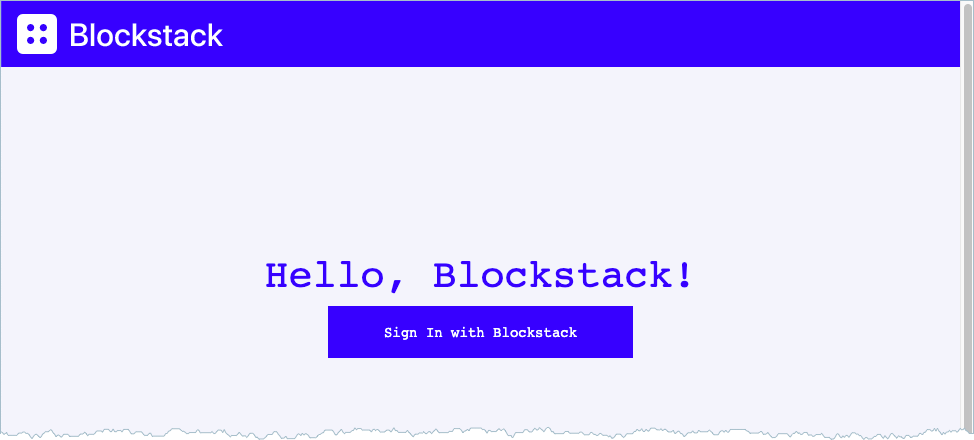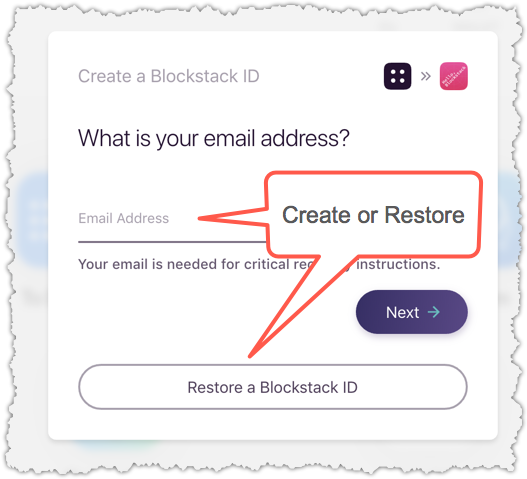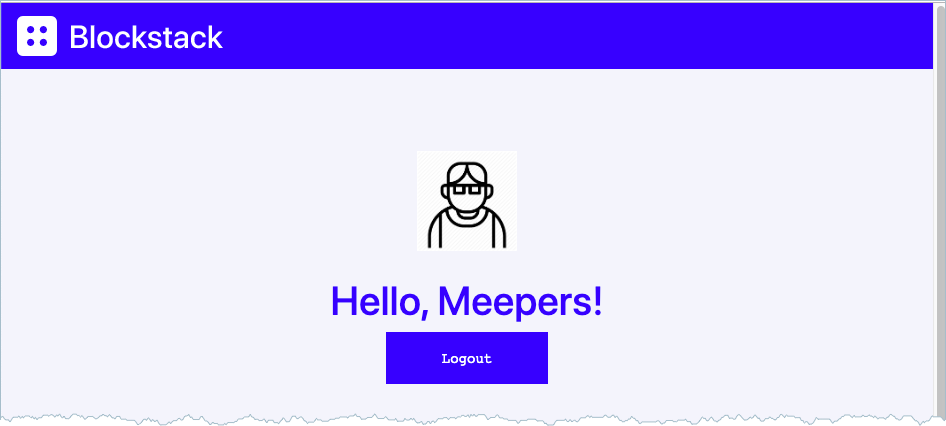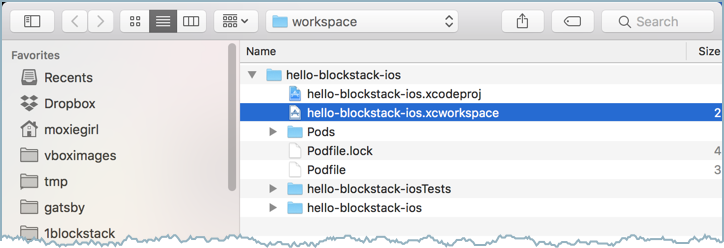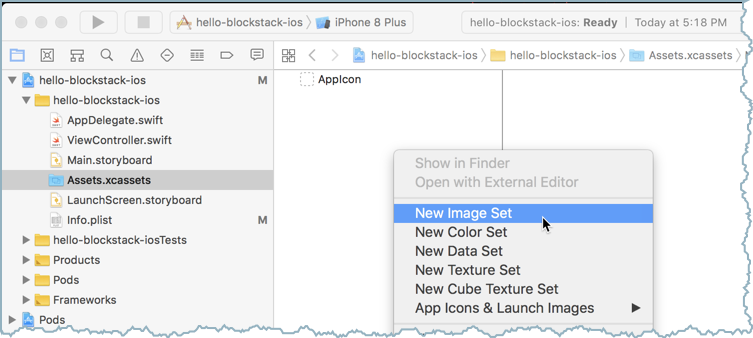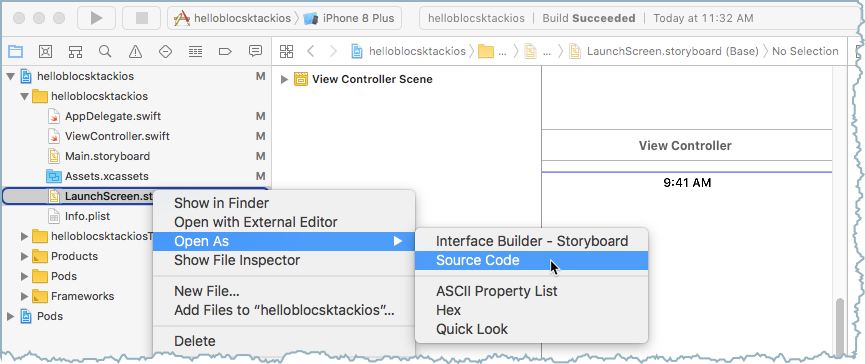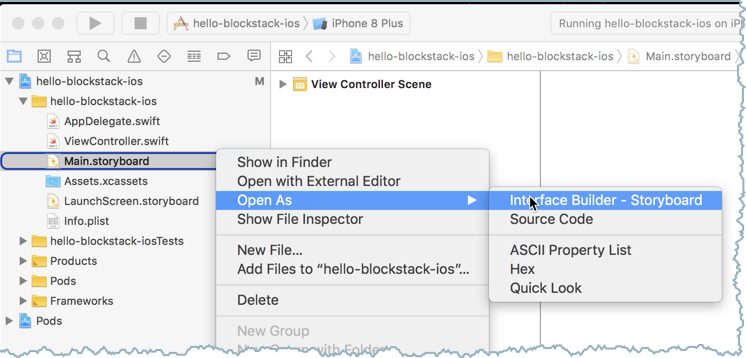26 KiB
| layout | description | permalink |
|---|---|---|
| learn | How to use Blockstack on iOS Mobile | /:collection/:path.html |
iOS SDK Tutorial (Pre-release)
{:.no_toc}
This tutorial teaches you how to create a decentralized application using Blockstack's iOS SDK using the following content:
- TOC {:toc}
This tutorial was extensively tested using Xcode Version 9.3 (9E145) on a MacBook Pro
running Mojave 10.14. If your environment is different, you may encounter
slight or even major discrepancies when performing the procedures in this
tutorial. Please join the Blockstack community Slack and post questions or comments to
the #support channel.
Finally, this tutorial is written for all levels from the beginner to the most experienced. For best results, beginners should follow the guide as written. It is expected that the fast or furiously brilliant will skip ahead and improvise on this material at will. God speed one and all.
If you prefer, you can skip working through the tutorial all together. Instead, you can download the final project code and import it into XCode to review it.
Understand the sample application flow
When complete, the sample application is a simple hello-world intended for use
on an iOS phone.
Only users with an existing blockstack.id can run your
final sample application. When complete, users interact with the sample
application by doing the following:
Set up your environment
This sample application requires two code bases, a BlockStack hello-blockstack web
application and a hello-ios iOS application. You use the iOS application to run the
web application on an iOS device.
Before you start developing the sample, there are a few elements you need in your environment.
Install XCode
If you are an experienced iOS developer and already have an iOS development environment on your workstation, you can use that and skip this step. However, you may need to adjust the remaining instructions for your environment.
Follow the installation instructions to download and XCode for your operating system. Depending on your network connection, this can take between 15-30 minutes.
Do you have Node.js?
Node.js v10 or higher is recommended the minimum supported version is Node.js v8. Before you begin, verify you have the correct version of Node.js and its tools installed.
$ node -v
v12.10.0
$ which npm npx
/usr/local/bin/npm
/usr/local/bin/npx
If you don't have these installed, take a moment to install or upgrade as needed.
Install the CocoaPods 1.6.0.beta.1 dependency manager
The sample application only runs on devices with iOS 11.0 or higher. You install the Blockstack iOS SDK through the CocoaPods. Cocoapods is a dependency manager for Swift and Objective-C Cocoa projects. It’s a simple, user friendly way to use libraries from the community in your project.
You must use the 1.6.0.beta.1 version of CocoaPods or newer to avoid an
incapability between Cocoapods and XCode. Before starting the tutorial, confirm
you have installed CocoaPods.
$ pod --version
1.6.0.beta.2
If you don't have the CocoaPods beta version, install it:
sudo gem install cocoapods -v 1.6.0.beta.2
Build the Blockstack hello-world
In this section, you build a Blockstack hello-world application. Then, you
modify the hello-world to interact with the iOS app via a redirect.
Generate and launch your hello-blockstack application
{% include scaffolding.md %}
In this section, you build an initial React.js application called
hello-blockstack.
-
Create a
hello-blockstackdirectory.mkdir hello-blockstack -
Change into your new directory.
cd hello-blockstack -
Create your initial
hello-world-tutorialapplication.$ npx generator-blockstack --react npx: installed 338 in 13.792s create package.json create .gitignore create webpack.config.js create netlify.toml create firebase.json ... I'm all done. Running npm install for you to install the required dependencies. If this fails, try running the command yourself. > fsevents@1.2.9 install /private/tmp/testymc/node_modules/fsevents > node install added 775 packages from 455 contributors and audited 9435 packages in 20.934s found 0 vulnerabilitiesDepending on your environment you may have some warnings with the installation. Optionally, you can fix these before continuing to the next section.
-
Run the initial application.
npm run start > hello-blockstack@0.0.0 start /Users/moxiegirl/repos/hello-blockstack > webpack-dev-server Project is running at http://localhost:8080/ webpack output is served from / 404s will fallback to /index.html Hash: 4d2312ba236a4b95dc3a Version: webpack 2.7.0 Time: 2969ms Asset Size Chunks Chunk Names .... Child html-webpack-plugin for "index.html": chunk {0} index.html 541 kB [entry] [rendered] [0] ./~/lodash/lodash.js 540 kB {0} [built] [1] ./~/html-webpack-plugin/lib/loader.js!./src/index.html 533 bytes {0} [built] [2] (webpack)/buildin/global.js 509 bytes {0} [built] [3] (webpack)/buildin/module.js 517 bytes {0} [built] webpack: Compiled successfully.At this point, the browser is running a Blockstack server on your local host.
-
Navigate to
http://localhost:8080with your browser to display the application.This local instances is for testing your applications only.
-
Choose Sign in with Blockstack
The system displays a prompt allowing you to create a new Blockstack ID or restore an existing one.
-
Follow the prompts appropriate to your situation.
If you are restoring an existing ID, you may see a prompt about your user being nameless, ignore it. At this point you have only a single application on your test server. So, you should see this single application, with your own
blockstack.iddisplay name, once you are signed in:
Add a redirect end point to your application
When a user opens the webapp from the Blockstack Browser on an iOS phone, you want the web app to redirect the user to your iOS application. The work you do here will allow it.
-
From the terminal command line, change directory to your web application directory (
hello-blockstack). -
If it doesn't ext, create the
publicdirectory.$ mkdir public -
Use the
touchcommand to add a redirect endpoint to your application.This endpoint on the web version of your app will redirect iOS users back to your mobile app.
$ touch public/redirect.html -
Open
redirect.htmland add code to the endpoint.<!DOCTYPE html> <html> <head> <title>Hello, Blockstack!</title> <script> function getParameterByName(name) { var match = RegExp('[?&]' + name + '=([^&]*)').exec(window.location.search); return match && decodeURIComponent(match[1].replace(/\+/g, ' ')); } var authResponse = getParameterByName('authResponse') window.location="myblockstackapp://?authResponse=" + authResponse </script> <body> </body> </html>Blockstack apps are identified by their domain names. The endpoint will receive a get request with the query parameter
authResponse=XXXXand should redirect the browser tomyblockstackapp:XXXX.myblockstackapp:is custom protocol handler. The handler should be unique to your application. Your app's web-based authentication uses this handler to redirect the user back to your iOS app. Later, you'll add a reference to this handler in your iOS application. -
Close and save the
redirect.htmlfile. -
Ensure your Blockstack app compiles successfully.
The
npmprocess should detect and compile your change.
Build the hello-blockstack-ios
Now, you build an iOS application that can access and run your Blockstack web application on a mobile device.
Create an XCode Project
This tutorial uses XCode 9.3, you can use another version but be aware that some menu items and therefore these procedures may be differœent on your version.
-
Launch the XCode interface.
-
Choose Create a new XCode project.
-
Select iOS.
-
Select Single View App.
-
Choose options for your new project for your project.
-
Press Next.
The system prompts you for a location to store your code.
-
Save your project in your
hello-blockstackdirectory.When you are done, you will have a
hello-blockstack/hello-blockstack-iossubdirectory. -
Close XCode.
Add and edit a Podfile
To use CocoaPods you need to define the XCode target to link them to.
So, for exampleM if you are writing an iOS app, it would be the name of your app.
Create a target section by writing target $TARGET_NAME do and an end a few
lines after.
-
Open a terminal window on your workstation.
-
Navigate to and change directory into the root of your project directory.
$ cd hello-blockstack-ios -
Create a Podfile.
$ pod initThe command creates a `Podfile` in the directory. -
Open the
Podfilefor editing. -
Add a line stating the Blockstack dependency.
# Uncomment the next line to define a global platform for your project # platform :ios, '9.0' target 'hello-blockstack-ios' do # Comment the next line if you're not using Swift and don't want to use dynamic frameworks use_frameworks! # Pods for hello-blockstack-ios pod 'Blockstack' target 'hello-blockstack-iosTests' do inherit! :search_paths # Pods for testing end end -
Save and close the
Podfile.
Install Blockstack SDK and open the pod project
-
Close your new XCode project.
-
Change to the root of your
hello-blockstack-iosproject. -
Initialize the project with Cocoapods.
$ pod install Analyzing dependencies Downloading dependencies Installing Blockstack (0.7.2) Installing CryptoSwift (0.15.0) Installing PromisesObjC (1.2.8) Installing PromisesSwift (1.2.8) Installing STRegex (2.1.0) Generating Pods project Integrating client project [!] Please close any current XCode sessions and use `hello-blockstack-ios.xcworkspace` for this project from now on. Sending stats Pod installation complete! There is 1 dependency from the Podfile and 2 total pods installed. [!] Automatically assigning platform `ios` with version `11.3` on target `hello-blockstack-ios` because no platform was specified. Please specify a platform for this target in your Podfile. See `https://guides.cocoapods.org/syntax/podfile.html#platform`.This command creates a number of files -
Review the files that the
podinstallation created:$ ls Podfile hello-blockstack-ios hello-blockstack-iosTests Podfile.lock hello-blockstack-ios.xcodeproj Pods hello-blockstack-ios.xcworkspace -
Start XCode and choose Open another project.
-
Choose the
.xcworkspacefile created in your project folder.When you open the workspace, the system will begin indexing the project. Then, after indexing, you may see a warning indicator at the top in the project title. If you see the warning, continue to step 7. Otherwise, go to the next section.
-
Click the signal to reveal the warning.
-
Click Update to recommended settings.
-
Choose Perform Changes and Continue when prompted.
The indicator disappears.
Choose a custom protocol handler
You'll need to choose a custom protocol handler that is unique to your app. This
is so that your app's web-based authentication redirect.html endpoint can redirect
the user back to your iOS app. In this example, you use myblockstackapp://.
-
Open the
.xcworkspacefile in XCode if it isn't open already. -
Select the top node of your project.
-
Select the Info tab in XCode.
-
Scroll to URL Types and press + (plus) sign.
-
Enter an Identifier and URL Schemes value.
| Identifier |
MyBlockstackApp| | URL Schemes |myblockstackapp| -
Set the Role to Editor.
When you are done the URL Types appears as follows:
Add a splash screen
All iOS applications require a splash page.
-
Select
Assets.xcassets -
Move your cursor into the area below Appicon.
-
Right click and choose New Image Set
-
Download the Blockstack icon.
-
Drag the downloaded file into the 3X position in your new Images folder.
-
Select the
LaunchScreen.storyboard. -
Choose Open As > Source Code.
-
Replace the content of the
<scenes>element with the following:<scenes> <!--View Controller--> <scene sceneID="EHf-IW-A2E"> <objects> <viewController id="01J-lp-oVM" sceneMemberID="viewController"> <view key="view" contentMode="scaleToFill" id="Ze5-6b-2t3"> <rect key="frame" x="0.0" y="0.0" width="375" height="667"/> <autoresizingMask key="autoresizingMask" widthSizable="YES" heightSizable="YES"/> <subviews> <imageView userInteractionEnabled="NO" contentMode="scaleToFill" horizontalHuggingPriority="251" verticalHuggingPriority="251" image="Image" translatesAutoresizingMaskIntoConstraints="NO" id="SpU-hA-y2f"> <rect key="frame" x="155.5" y="273" width="64" height="64"/> </imageView> <label opaque="NO" userInteractionEnabled="NO" contentMode="left" horizontalHuggingPriority="251" verticalHuggingPriority="251" text="Hello Blockstack iOS" textAlignment="natural" lineBreakMode="tailTruncation" baselineAdjustment="alignBaselines" adjustsFontSizeToFit="NO" translatesAutoresizingMaskIntoConstraints="NO" id="Wfj-A6-BZM"> <rect key="frame" x="108" y="432" width="158" height="21"/> <fontDescription key="fontDescription" type="system" pointSize="17"/> <nil key="textColor"/> <nil key="highlightedColor"/> </label> </subviews> <color key="backgroundColor" red="1" green="1" blue="1" alpha="1" colorSpace="custom" customColorSpace="sRGB"/> <constraints> <constraint firstItem="Wfj-A6-BZM" firstAttribute="centerX" secondItem="6Tk-OE-BBY" secondAttribute="centerX" id="AZy-qf-xHq"/> <constraint firstItem="Wfj-A6-BZM" firstAttribute="top" secondItem="6Tk-OE-BBY" secondAttribute="top" constant="412" id="SwP-qV-1RP"/> <constraint firstItem="SpU-hA-y2f" firstAttribute="centerX" secondItem="6Tk-OE-BBY" secondAttribute="centerX" id="XdI-Db-fDo"/> <constraint firstItem="SpU-hA-y2f" firstAttribute="top" secondItem="6Tk-OE-BBY" secondAttribute="top" constant="253" id="xc5-po-W1E"/> </constraints> <viewLayoutGuide key="safeArea" id="6Tk-OE-BBY"/> </view> </viewController> <placeholder placeholderIdentifier="IBFirstResponder" id="iYj-Kq-Ea1" userLabel="First Responder" sceneMemberID="firstResponder"/> </objects> <point key="canvasLocation" x="52" y="374.66266866566718"/> </scene> </scenes> -
Immediately after scenes but before the close of the
</document>tag add the following<resources>.<resources> <image name="Image" width="64" height="64"/> </resources> </document> -
Choose Run > Run app in the emulator.
The emulator now contains a new splash screen.
Update the Main.storyboard
Rather than have you build up your own UI, this section has you copy and paste a layout into the XML file source code for the Main.storyboard file.
-
Select the
Main.storyboardfile. -
Choose Open As > Source Code
The
blockstack-example/blockstack-example/Base.lproj/Main.storyboardfile defines the graphical elements. Some elements are required before you can functionality to your code. -
Within the
<viewController>element, replace the existing<view>subelement with the following:<view key="view" contentMode="scaleToFill" id="8bC-Xf-vdC"> <rect key="frame" x="0.0" y="0.0" width="375" height="667"/> <autoresizingMask key="autoresizingMask" widthSizable="YES" heightSizable="YES"/> <subviews> <label opaque="NO" userInteractionEnabled="NO" contentMode="left" horizontalHuggingPriority="251" verticalHuggingPriority="251" text="hello-blockstack-ios" textAlignment="center" lineBreakMode="tailTruncation" baselineAdjustment="alignBaselines" adjustsFontSizeToFit="NO" translatesAutoresizingMaskIntoConstraints="NO" id="9eE-ZS-LU9"> <rect key="frame" x="0.0" y="101" width="375" height="50"/> <color key="backgroundColor" red="0.44735813140000003" green="0.1280144453" blue="0.57268613580000005" alpha="1" colorSpace="custom" customColorSpace="sRGB"/> <constraints> <constraint firstAttribute="height" constant="50" id="U5v-13-4Ux"/> </constraints> <fontDescription key="fontDescription" type="system" pointSize="17"/> <color key="textColor" white="1" alpha="1" colorSpace="custom" customColorSpace="genericGamma22GrayColorSpace"/> <nil key="highlightedColor"/> </label> <button opaque="NO" contentMode="scaleToFill" contentHorizontalAlignment="center" contentVerticalAlignment="center" buttonType="roundedRect" lineBreakMode="middleTruncation" translatesAutoresizingMaskIntoConstraints="NO" id="Lfp-KX-BDb"> <rect key="frame" x="100" y="382" width="175" height="40"/> <color key="backgroundColor" red="0.1215686275" green="0.12941176469999999" blue="0.14117647059999999" alpha="1" colorSpace="custom" customColorSpace="sRGB"/> <constraints> <constraint firstAttribute="height" constant="40" id="8fN-Ro-Krn"/> </constraints> <color key="tintColor" white="0.0" alpha="1" colorSpace="calibratedWhite"/> <state key="normal" title="Sign into Blocksack"> <color key="titleColor" white="1" alpha="1" colorSpace="custom" customColorSpace="genericGamma22GrayColorSpace"/> </state> <connections> <action selector="signIn:" destination="BYZ-38-t0r" eventType="touchUpInside" id="nV7-rt-euZ"/> </connections> </button> </subviews> <color key="backgroundColor" red="1" green="1" blue="1" alpha="1" colorSpace="custom" customColorSpace="sRGB"/> <constraints> <constraint firstItem="9eE-ZS-LU9" firstAttribute="leading" secondItem="6Tk-OE-BBY" secondAttribute="leading" id="2ZP-tU-h9Y"/> <constraint firstItem="9eE-ZS-LU9" firstAttribute="top" secondItem="6Tk-OE-BBY" secondAttribute="top" constant="81" id="DBh-q0-pAV"/> <constraint firstItem="6Tk-OE-BBY" firstAttribute="trailing" secondItem="Lfp-KX-BDb" secondAttribute="trailing" constant="100" id="MHO-ew-4Bd"/> <constraint firstItem="Lfp-KX-BDb" firstAttribute="leading" secondItem="6Tk-OE-BBY" secondAttribute="leading" constant="100" id="Rsm-LP-ya7"/> <constraint firstItem="Lfp-KX-BDb" firstAttribute="top" secondItem="6Tk-OE-BBY" secondAttribute="top" constant="362" id="chE-B7-ya6"/> <constraint firstItem="6Tk-OE-BBY" firstAttribute="trailing" secondItem="9eE-ZS-LU9" secondAttribute="trailing" id="j0x-8j-04u"/> </constraints> <viewLayoutGuide key="safeArea" id="6Tk-OE-BBY"/> </view>
Add the UI variables to the ViewController file.
In this section, you edit the ViewController.swift file using the storyboard as a starting point.
-
Select the Main.storyboard and choose Open As > Interface Builder - storyboard.
-
With the interface builder open, display the
ViewController.swiftfile in the right panel. -
In the storyboard, select the Sign into Blockstack button.
-
Control-drag from the button to the code display in the editor on the right, stopping the drag at the line below controller's opening statement.
-
Repeat this process with the storyboard's purple hello-blockstack-ios label.
When you are done, your 'ViewController' file contains the following variables:
class ViewController: UIViewController { @IBOutlet var nameLabel: UILabel! @IBOutlet var signInButton: UIButton!And XCode has added two outlines to the
Main.storyboardsource.<connections> <outlet property="nameLabel" destination="9eE-ZS-LU9" id="Ahv-Te-ZZo"/> <outlet property="signInButton" destination="Lfp-KX-BDb" id="yef-Jj-uPt"/> </connections>Your connectors will have their own
destinationandidvalues.
Edit the ViewController.swift file
Now, you are ready to connect your application with your Blockstack Web Application. Normally, after building your Web application you would have registred it with Blockstack and the app would be available on the Web. This example skips this registration step and uses an example application we've already created for you:
https://heuristic-brown-7a88f8.netlify.com/redirect.html
This web application already has a redirect in place for you. You'll reference this application in your mobile add for now. In XCode, do the following;
-
Open the
ViewController.swiftfile. -
Add an import both for
Blockstack.import UIKit import Blockstack -
Add a private
updateUI()function.This function takes care of loading the user data from Blockstack.
private func updateUI() { DispatchQueue.main.async { if Blockstack.shared.isUserSignedIn() { // Read user profile data let retrievedUserData = Blockstack.shared.loadUserData() print(retrievedUserData?.profile?.name as Any) let name = retrievedUserData?.profile?.name ?? "Nameless Person" self.nameLabel?.text = "Hello, \(name)" self.nameLabel?.isHidden = false self.signInButton?.setTitle("Sign Out", for: .normal) print("UI update SIGNED_IN") } else { self.nameLabel?.text = "hello-blockstack-ios" self.signInButton?.setTitle("Sign into Blockstack", for: .normal) print("UI update SIGNED_OUT") } } }The function uses the
Blockstack.shared.isUserSignedIn()method to determine if the user is already logged into Blockstack or not. It then uses theBlockstack.shared.loadUserData()method to load the user data and update the application display with the username. -
Replace the content of the
viewDidLoad()function so that it calls this private function.override func viewDidLoad() { super.viewDidLoad() // Do any additional setup after loading the view, typically from a nib. self.updateUI() } -
Create a 'signIn()' function that handles both sign in and out.
The function uses the
Blockstack.shared.signIn()andBlockstack.shared.signUserOut()methods to sign the user into the application.@IBAction func signIn(_ sender: UIButton) { if Blockstack.shared.isUserSignedIn() { print("Currently signed in so signing out.") Blockstack.shared.signUserOut() self.updateUI() } else { print("Currently signed out so signing in.") // Address of deployed example web app Blockstack.shared.signIn(redirectURI: "https://heuristic-brown-7a88f8.netlify.com/redirect.html", appDomain: URL(string: "https://heuristic-brown-7a88f8.netlify.com")!) { authResult in switch authResult { case .success(let userData): print("Sign in SUCCESS", userData.profile?.name as Any) self.updateUI() case .cancelled: print("Sign in CANCELLED") case .failed(let error): print("Sign in FAILED, error: ", error ?? "n/a") } } } }
Troubleshooting your build in XCode
XCode builds can retain old data. To ensure your builds are clean, try the following:
- Reset the simulator by choosing Hardware -> Erase all content and settings from the menu.
- In XCode, clean the project by choosing Product > Clean from the menu or press 'Command + Shift + K' on your keyboard.
- Clean the build folder by pressing 'Command + Option + Shift + K' on your keyboard.
- Run the code on the simulator again.
